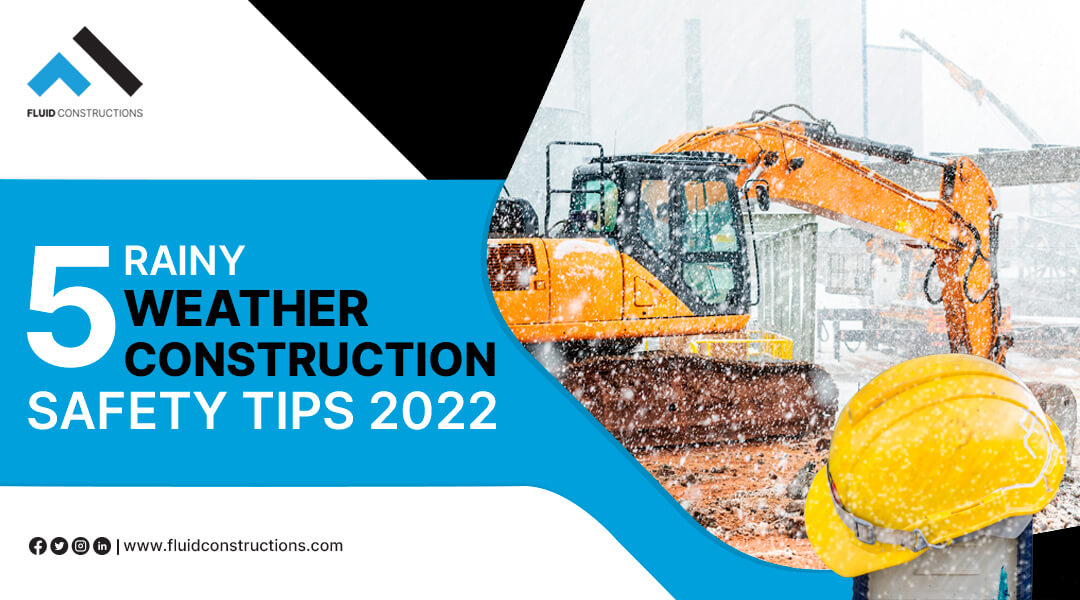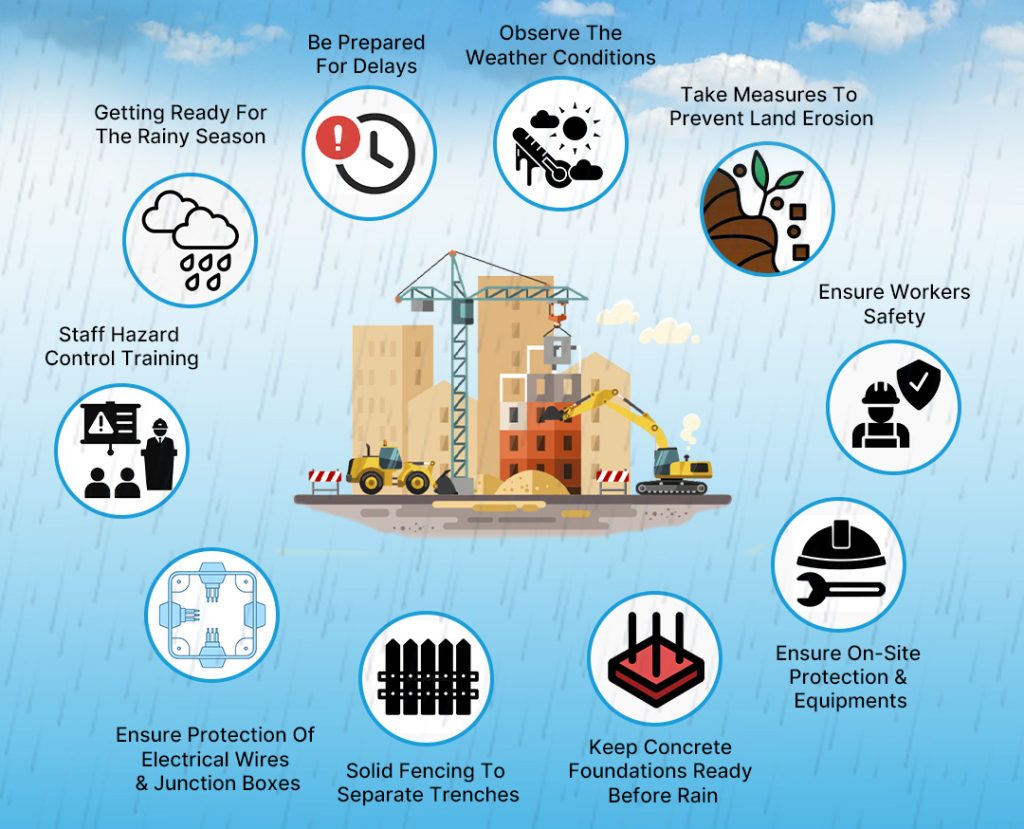
10 Rainy Weather Construction Safety Tips 2023
Construction sites per se are accident-prone and become more so during the rainy season. Fall from a roof, ladder, or scaffold, electrocution of individuals, or injuries from stepping on sharp objects – types of accidents at a construction site can be many and can happen any time, but their chances multiply during the rainy season.
Therefore, as the developer or project manager of a construction site, the onus lies on you to take measures and precautions to avert accidents as much as possible and ensure undisrupted work through the rainy season.

Getting Ready for Rainy Season
Incessant rain, thunderstorms, and other conditions are common during the rainy season that can stall your project work and cause damage to the instruments. Even the health of the workers may become a major concern for you.
You must be proactive to minimize the negative impacts of rain and save your project from incurring additional expenses due to these factors. The hazards that your project may encounter due to cyclonic situations during the rainy seasons are:
- Falling of big trees and roadblocks due to that
- Live electrical wires hanging dangerously from the leaning poles
- Lightning strikes
- Flooding
- Sediment runoff and pollution
- Slips and falls
- Cave-ins and structural collapses
Follow these safety precautions during the rainy season whether you are running a civil, road, or industrial construction site:
Be prepared for delays
To finish a project on schedule and under budget, take into account unexpected delays while managing a contract with developers.
If it rains incessantly, it may cause either delays or complete suspension of works on those days. It is also necessary to have some buffer time and money for equipment breakdowns and potential damage, which are very probable if the bad weather persists.
Your best strategy against potential liabilities and expensive project delays will be to minimize your risk as much as you can by taking the appropriate measures and negotiating more leniency in the contract.
Observe the weather conditions
Generally speaking, this advice should be used all year long. An up-to-date weather forecast will enable you to plan your work around probable rainfall, avoiding exposing untreated wood or freshly laid concrete to damaging rains.
If constructed during continuous rainfall that causes the soil to become loose, wells and sewage systems may also be vulnerable to collapse.
Take measures to prevent land erosion
Soil erosion at the construction site can endanger workers and tools and cause stormwater deposits at places that pollute the local environment. Create a stormwater management plan with appropriate erosion/sediment control techniques, including silt fences, sediment traps, or basins.
You may consult an environmental consultant to develop a SWPPP plan to help avoid land erosion problems during the rainy seasons in projects spanning over an acre of land.
Ensure workers safety
When working in the rain, workers should wear well-fitting waterproof protective clothing that does not obstruct their motions, such as helmets, raincoats, rain boots, and hand protection with a slip-resistant grip. When it rains walkways, rooftops, other locations, and equipment become slippery. To avoid falling, workers should wear proper footwear that can protect them from slipping.
Wearing high-visibility jackets is also very important for construction workers as a safety measure from potential weather hazards. It will help to locate your workers during rescue when visibility is challenged through heavy rain.
Ensure on-site protection and equipments
It’s difficult to work in the rain. You should take precautions to prevent water from entering the job site and potentially damaging your equipment. When your workers must perform their work outside, it would be better to construct a temporary shed for them.
The usage of waterproof tarps is a cost-efficient and successful solution. Construction equipment and supplies can also be protected with tarps. For easy set-up and installation, choose high-quality tarps with grommets.
Keep concrete foundations ready before rain
It’s always good for a concrete structure to be exposed to rain. Thus the secret to constructing a building in the rainy season is to get the foundation in place and the structure up off the ground before the rainy season starts.
However, you require experienced workers and appropriate equipment to build the foundation and the structure. Remove any water deposit before pouring concrete on the footings. If the rain is so strong that water cannot be removed completely, concrete pouring should be postponed until a later date.
Solid fencing to separate trenches
Excavation pits and cavities are potentially high prone areas for accidents, especially during monsoon. You must use appropriate barrier or fencing to separate the deep gorge and trenches
from walkways. Display suitable warning signs, caution tape, reflective tape, and a rotating / flickering red light, if required.
Keep excavated earth out of trenches and pits. Backfill all gorges and cavities, which are not to be used.
Wet weather causes trench walls to cave in. Ask workers to avoid deep trenches during heavy rain unless they are certain that they are protected by a trench box or have a very solid wall.
Ensure protection of electrical wires and junction boxes
Electrocution and electrical short circuits are highly probable at construction sites especially during the rainy season, if safety rules are not maintained. Ensure proper insulation and protective covers for all electrical cables, junction boxes, and equipment. Educate workers of the do’s and don’ts of using electrical instruments and to inform the authorities if they see live wire jutting out
Staff Hazard Control Training
To prepare the construction crew at the project site to deal with hazardous situations, it’s necessary to train them in hazard detection and control.
Workers must correctly mark out trenches to prevent mishaps in low visibility, examine equipment before use, and even create erosion control perimeters to prevent sediment runoff in addition to working around live wires and slippery surfaces.
Construction managers and workers should also receive training on stopping projects or warning others when hazards are present, as well as how to report any accidents in your reporting system.
Instruct workers to maintain the guidelines
Heavy gusts that are frequently brought on by monsoons could reveal concealed fissures or gaps in buildings that were left unfinished during construction. Anyone who falls into one of these apertures unintentionally runs a danger of harm, especially since walls or other structures may hide them from view from the ground.
Inform your employees to avoid particular places during the rainy season since they run the chance of getting into an accident by falling into a ditch or trench, which might result in serious injury or even death and take hours or days to be rescued.
A long and forceful rainy season is a concern for every construction project manager as it not only disrupts work indefinitely but might cause injuries and even death to the workers creating obstacles and delays to the project. The measures covered in this blog will help you to ensure the safety of the workers and minimize losses due to rain hazards. To learn more about this write to us at [email protected]
